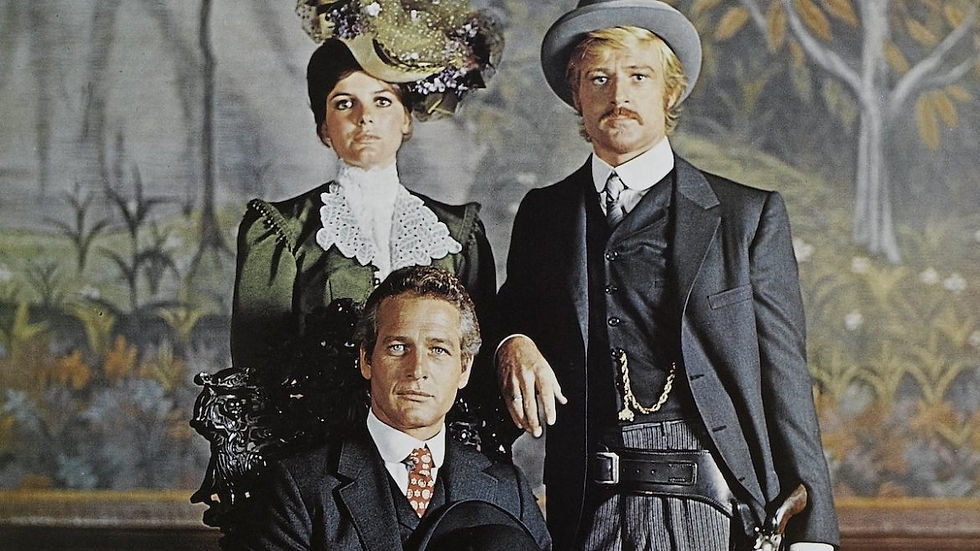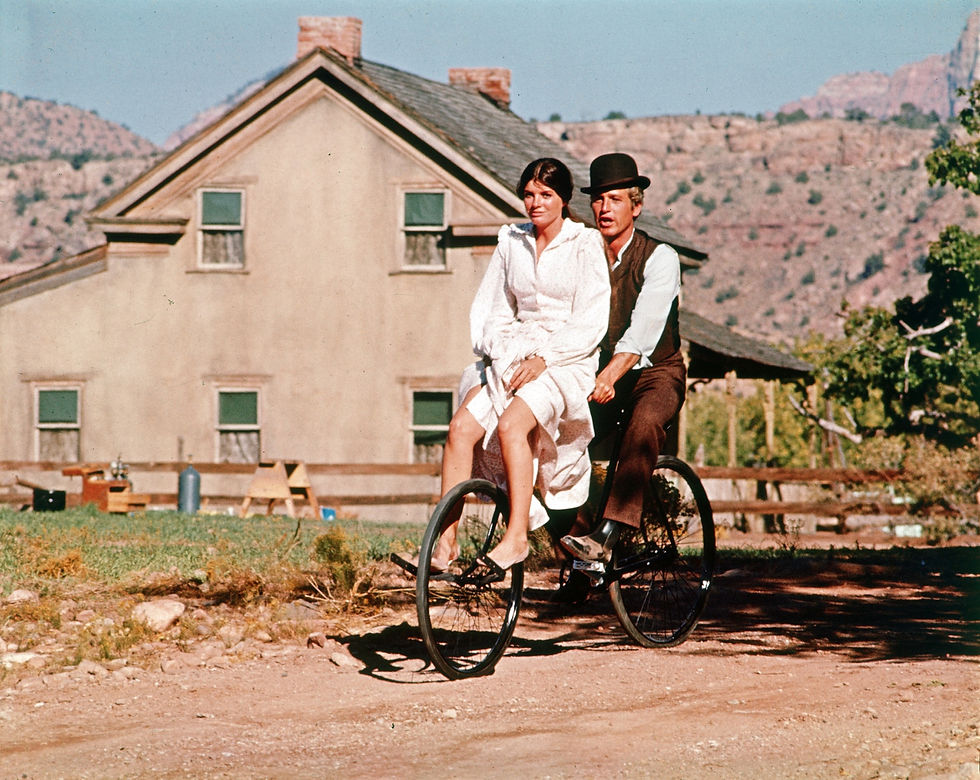Butch Cassidy and the Sundance Kid (1969)
- Soames Inscker

- Apr 3
- 5 min read
Updated: Jun 7

A Daring and Iconic Revisionist Western
Few films manage to redefine a genre while becoming a timeless classic, but Butch Cassidy and the Sundance Kid (1969) does just that. Directed by George Roy Hill and starring Paul Newman and Robert Redford, this film blends action, humour, and tragedy into an unforgettable cinematic experience. With a sharp, witty screenplay by William Goldman, stunning cinematography, and an iconic musical score, Butch Cassidy and the Sundance Kid is a landmark in the Western genre, offering a fresh take on the outlaw legend while maintaining an undeniable sense of fun.
More than 50 years after its release, the film remains one of the greatest Westerns ever made, a story of loyalty, adventure, and the inevitable passing of time.
A Story of Outlaws and Change
Set in the early 1900s, Butch Cassidy and the Sundance Kid follows the adventures of two legendary outlaws: Butch Cassidy (Paul Newman), the charismatic and quick-witted leader of the Hole-in-the-Wall Gang, and the Sundance Kid (Robert Redford), a silent, brooding gunslinger with unmatched shooting skills.
As the film opens, Butch and Sundance are at the height of their criminal careers, robbing banks and trains with a playful sense of invincibility. However, the world around them is changing. The Wild West is becoming more civilised, and law enforcement is no longer a joke. When a relentless posse is sent after them—comprised of some of the best trackers in the country—the duo finds themselves constantly on the run, realising that their way of life is rapidly coming to an end.
Fleeing to Bolivia with Sundance’s lover, Etta Place (Katharine Ross), they attempt to start fresh as bank robbers in a foreign land. However, they soon discover that even in Bolivia, they cannot escape their past. The film builds towards a thrilling yet tragic climax, cementing their place as legends in the outlaw myths.
Paul Newman and Robert Redford: The Perfect Duo

One of the biggest reasons Butch Cassidy and the Sundance Kid remains so beloved is the electrifying chemistry between Paul Newman and Robert Redford. Their dynamic is effortless, with each actor playing off the other’s strengths to create one of the most iconic duos in film history.
Paul Newman as Butch Cassidy
Newman brings immense charm and humour to the role of Butch. He is a strategist and a talker, always looking for a clever way out of a situation. Unlike the traditional rugged Western hero, Butch relies on his wit and charisma rather than brute force. Newman’s performance makes him irresistibly likeable, even when he is robbing trains and banks.
Robert Redford as the Sundance Kid
In contrast to Butch’s easygoing nature, Redford plays Sundance as a man of few words but plenty of action. His stoic demeanour and expert marksmanship make him an intimidating presence, yet Redford adds subtle layers of vulnerability to the character.
Together, they create an onscreen partnership that is both hilarious and deeply moving. Their constant banter and unwavering loyalty to each other make their journey all the more engaging.
A Revolutionary Take on the Western Genre
By the late 1960s, the classic Hollywood Western was fading, with audiences gravitating toward grittier, more realistic depictions of the American West, as seen in films like The Wild Bunch (1969) and Once Upon a Time in the West (1968). Butch Cassidy and the Sundance Kid took a different approach—it infused the genre with humour, modern sensibilities, and an irreverent tone that made it stand apart.
While it features many of the hallmarks of a traditional Western—gunfights, train robberies, horseback chases—it subverts expectations at every turn. Instead of glorifying violence, the film treats it as something chaotic and unpredictable. Instead of painting the outlaws as larger-than-life heroes, it presents them as flawed, charming, and ultimately doomed figures.
Even the film’s most intense moments are punctuated with humour, making it a rare blend of comedy and tragedy.
William Goldman’s Brilliant Screenplay
One of the film’s greatest strengths is its Oscar-winning screenplay, written by William Goldman. The dialogue is razor-sharp, filled with witty exchanges that make Butch and Sundance endlessly entertaining to watch. Some of the film’s most memorable lines have become classics:
Sundance: "I can’t swim."
Butch: "Are you crazy? The fall will probably kill you!"
Goldman also injects the script with a self-awareness that was rare in Westerns at the time. The characters frequently question their own abilities, and there’s a running joke about Butch being unable to fight because he has never had to. This meta-humour makes the film feel fresh and modern, even decades after its release.
The Iconic Music and “Raindrops Keep Fallin’ on My Head”

One of the most surprising elements of Butch Cassidy and the Sundance Kid is its unconventional use of music. Instead of a traditional Western score, the film features contemporary compositions by Burt Bacharach, including the now-famous “Raindrops Keep Fallin’ on My Head.”
The song plays during a lighthearted bicycle-riding montage featuring Butch and Etta, a sequence that some critics initially found out of place in a Western. However, the scene has since become one of the most beloved moments in the film, showcasing Butch’s playful, carefree spirit while subtly foreshadowing the fleeting nature of their happiness.
Bacharach’s music helps set the film apart from other Westerns, adding a whimsical, almost nostalgic quality to the story.
Conrad Hall’s Stunning Cinematography
Visually, Butch Cassidy and the Sundance Kid is a masterpiece. Cinematographer Conrad Hall’s work captures the beauty of the American West with sweeping landscapes and breathtaking natural light. His innovative use of sepia tones in flashback sequences adds a dreamlike, nostalgic feel, reinforcing the idea that Butch and Sundance belong to a past era that is quickly disappearing.
Hall’s cinematography won the Academy Award for Best Cinematography, and rightfully so—the film is filled with unforgettable visual compositions.
A Bittersweet and Unforgettable Ending
The film’s climax is one of the most iconic in cinema history. As Butch and Sundance make their final stand against the Bolivian army, the film freezes on their final, defiant charge. Instead of showing their inevitable deaths, the movie leaves them forever suspended in time, legends in their own right.
This ending is both tragic and poetic, solidifying Butch Cassidy and the Sundance Kid as more than just an adventure—it is a film about the end of an era, the death of the outlaw, and the passage of time.
A Lasting Legacy
Upon its release, Butch Cassidy and the Sundance Kid was a massive success, becoming one of the highest-grossing films of 1969. It won four Academy Awards, including Best Original Screenplay and Best Cinematography. More importantly, it redefined the buddy film, paving the way for future classics like The Sting (1973), Lethal Weapon (1987), and Pulp Fiction (1994).
The film also catapulted Robert Redford to stardom and solidified Paul Newman as one of Hollywood’s most beloved leading men. Their on-screen chemistry led to their reunion in The Sting, another classic collaboration.
Final Verdict: A Western Like No Other
Butch Cassidy and the Sundance Kid is a near-perfect film. It is funny, thrilling, visually stunning, and deeply poignant. With legendary performances, an unforgettable script, and an ending that lingers in the mind long after the credits roll, it is a film that stands the test of time.






